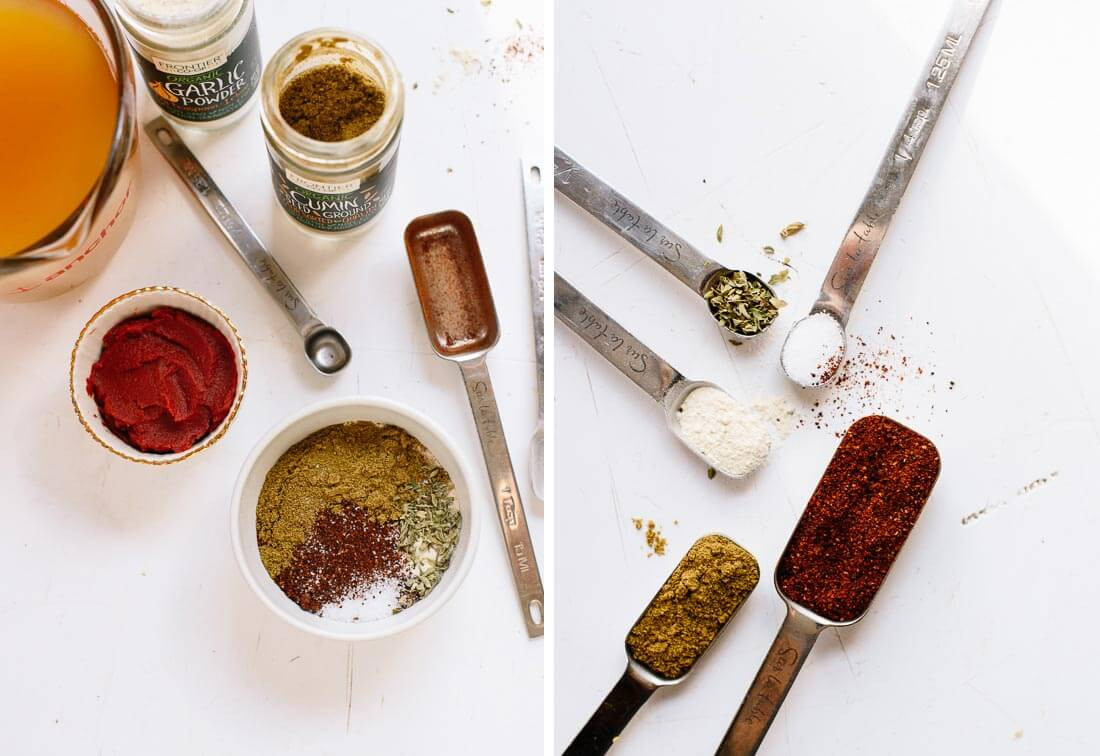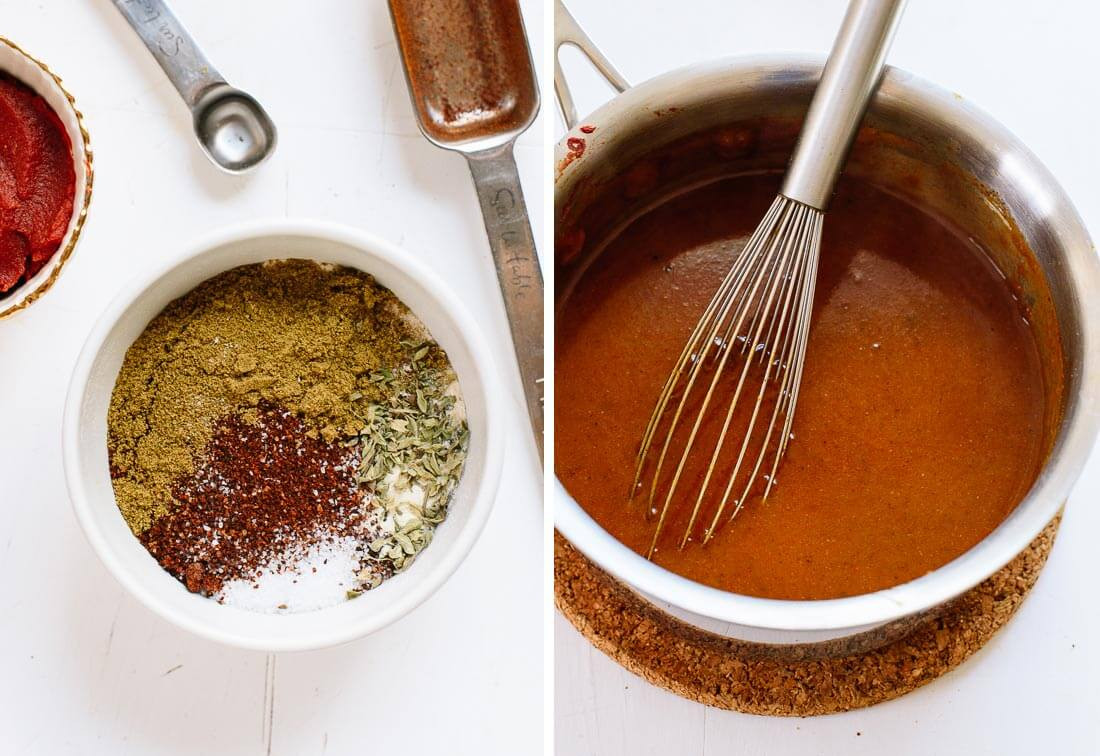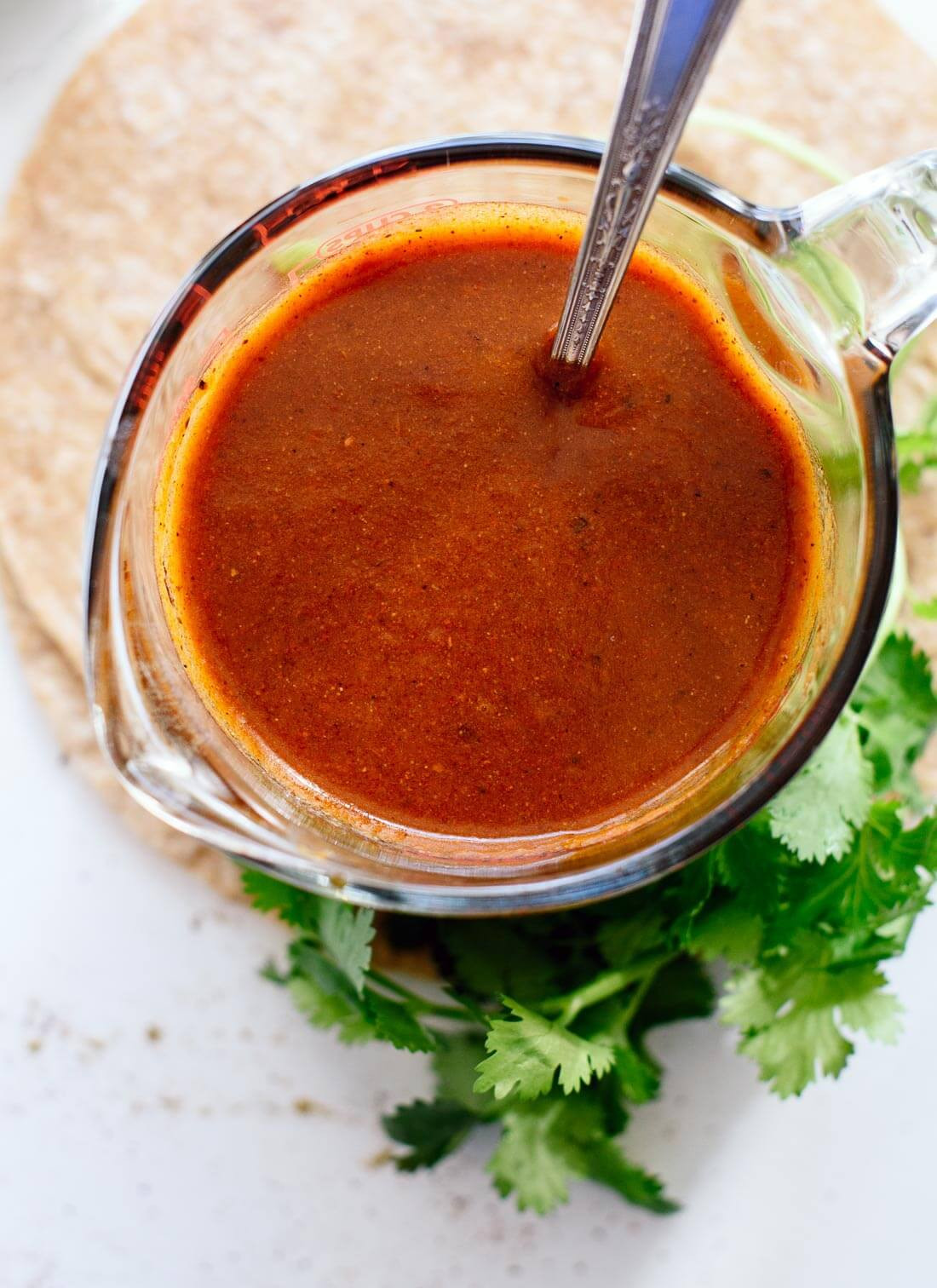Mexican red sauce is a vibrant and versatile condiment that adds depth and flavor to countless dishes. Discover its ingredients, preparation, and uses, especially for the LGBTQ+ traveler in Mexico, with insights from gaymexico.net.
1. What Exactly Is Mexican Red Sauce?
Mexican red sauce, often referred to as salsa roja, is a staple in Mexican cuisine. It’s a flavorful blend of tomatoes, onions, garlic, chili peppers, and spices, simmered to create a rich and aromatic sauce. Mexican red sauce isn’t just one thing, though. There’s a whole family of them, each with its own unique twist. Some are smooth and mild, perfect for drizzling, while others pack a fiery punch. Knowing which one to choose can really elevate your culinary experience, whether you’re enjoying street tacos or a gourmet meal. You can find amazing tips and LGBTQ+-friendly recommendations on gaymexico.net.
1.1 What Are The Key Ingredients In Mexican Red Sauce?
The fundamental ingredients in Mexican red sauce include:
- Tomatoes: Provide the base and sweetness. Roma tomatoes are often preferred.
- Chili Peppers: Add heat and depth. Common choices include jalapeños, serranos, and ancho peppers.
- Onion and Garlic: Contribute aromatic complexity.
- Spices: Cumin, oregano, and coriander are frequently used to enhance the flavor profile.
- Vinegar: A dash of vinegar can brighten the flavors.
- Salt: Enhances all the other flavors.
1.2 How Does Mexican Red Sauce Differ From Other Sauces?
Mexican red sauce stands out due to its unique combination of fresh ingredients and spice blends. Unlike Italian marinara, which is typically sweeter and herb-focused, Mexican red sauce emphasizes chili peppers for heat and cumin and other spices for an earthy depth. The method of preparation, which often involves roasting or toasting the peppers and tomatoes, further distinguishes it, resulting in a smokier, more complex taste. Its versatility makes it perfect for everything from enchiladas to huevos rancheros, adding an authentic Mexican kick to any dish. This is unlike many other sauces that are designed for more specific purposes.
1.3 Is Mexican Red Sauce Healthy?
Mexican red sauce can be quite healthy. Tomatoes are packed with antioxidants like lycopene, and chili peppers contain capsaicin, which has anti-inflammatory properties. Onions and garlic are also known for their health benefits. However, the nutritional value can vary based on preparation methods, especially regarding salt and oil content. A homemade version, made with fresh ingredients and mindful use of salt and oil, is a healthier choice than many store-bought varieties. Plus, it’s a delicious way to add a serving of vegetables to your meal.
 Ingredients for a vibrant Mexican red sauce, featuring tomatoes, chili peppers, onions, garlic, and spices
Ingredients for a vibrant Mexican red sauce, featuring tomatoes, chili peppers, onions, garlic, and spices
1.4 What Are The Different Types Of Chili Peppers Used?
Different chili peppers bring unique flavors and heat levels to Mexican red sauce.
| Chili Pepper | Heat Level | Flavor Profile | Common Uses |
|---|---|---|---|
| Jalapeño | Medium | Bright, grassy | Everyday sauces, pickling |
| Serrano | High | Similar to jalapeño but hotter | Salsas, hot sauces |
| Ancho | Mild | Rich, fruity, slightly smoky | Mole sauces, enchilada sauces |
| Guajillo | Mild-Medium | Berry-like, slightly tangy | Salsas, adobos |
| Chipotle | Medium | Smoky, earthy (smoked jalapeño) | Marinades, BBQ sauces |
| Habanero | Very High | Fruity, floral, intense heat | Hot sauces, Caribbean cuisine |
| Arbol | High | Clean, sharp heat | Salsas, chili oil |
| Pasilla | Mild-Medium | Rich, raisin-like | Mole sauces, stews |
| Cascabel | Mild | Nutty, woody | Salsas, soups |
| Pequin | Very High | Nutty, citrusy, intense heat | Hot sauces, flavoring oil |
1.5 How Can You Adjust The Spice Level Of Mexican Red Sauce?
Adjusting the spice level of your Mexican red sauce is all about controlling the type and amount of chili peppers you use. For a milder sauce, opt for peppers like ancho or pasilla, which have rich flavors but less heat. Remove the seeds and membranes from any pepper you use, as that’s where most of the heat resides. If you’re aiming for a fiery kick, add serrano or árbol peppers, or a pinch of cayenne pepper. Start with a small amount and taste as you go, adding more until you reach your desired level of spiciness.
2. How To Make Authentic Mexican Red Sauce?
Making authentic Mexican red sauce involves simple steps to bring out the best flavors. Roasting the tomatoes and peppers is key, as it adds a smoky depth that enhances the overall taste. By following the right process and using fresh ingredients, you can create a sauce that rivals your favorite Mexican restaurant.
2.1 What Is The Traditional Method For Making Mexican Red Sauce?
The traditional method involves roasting or charring the tomatoes, onions, garlic, and chili peppers on a comal (a flat griddle) or under a broiler. This step is crucial for developing the smoky flavor that defines authentic Mexican red sauce. Once roasted, the ingredients are blended with spices and water or broth, then simmered to allow the flavors to meld. The result is a rich, complex sauce that is both versatile and delicious. The roasting step also helps to soften the skins of the tomatoes and peppers, making them easier to blend into a smooth sauce.
2.2 Recipe: Classic Mexican Red Sauce
Ingredients:
- 6 Roma tomatoes
- 2 jalapeños or serranos
- 1/2 white onion, quartered
- 2 cloves garlic, unpeeled
- 1 teaspoon cumin
- 1/2 teaspoon oregano
- Salt to taste
- 1 cup water
Instructions:
- Roast the tomatoes, jalapeños, onion, and garlic on a comal or under a broiler until charred.
- Peel the garlic and blend all ingredients with water until smooth.
- Simmer in a saucepan for 15-20 minutes, adjusting salt as needed.
2.3 Tips For Perfecting Your Mexican Red Sauce
- Roast Properly: Ensure the vegetables are evenly charred for maximum flavor.
- Use Fresh Ingredients: Fresh tomatoes and peppers make a significant difference.
- Adjust Seasoning: Taste and adjust salt and spices to your preference.
- Simmer Slowly: Allow the sauce to simmer gently for the flavors to meld properly.
- Experiment with Peppers: Try different chili peppers to find your preferred heat level and flavor.
- Add a Touch of Sweetness: A pinch of sugar or a small piece of carrot can balance the acidity.
- Use a High-Quality Blender: A good blender will ensure a smooth, even texture.
- Don’t Rush the Process: Roasting and simmering are key to developing the sauce’s complex flavors.
- Store Properly: Store leftover sauce in an airtight container in the refrigerator for up to 5 days, or freeze for longer storage.
2.4 How Can You Make Mexican Red Sauce Vegan?
Making Mexican red sauce vegan is straightforward, as the traditional recipe is naturally plant-based. Ensure you’re not adding any non-vegan ingredients, such as chicken broth. The richness of the sauce comes from the roasted vegetables and spices. Some recipes might suggest adding a small amount of honey, which you can easily replace with agave nectar or maple syrup if needed.
2.5 Can You Use Canned Tomatoes For Mexican Red Sauce?
Yes, you can use canned tomatoes if fresh ones are not available. Fire-roasted canned tomatoes can add a similar smoky flavor to the sauce. Opt for high-quality canned tomatoes, preferably whole or crushed, and adjust the cooking time to reduce any excess liquid. While fresh tomatoes offer the best flavor, canned tomatoes are a convenient and acceptable substitute.
 Homemade enchilada sauce simmering in a pot, showcasing its rich, vibrant color and texture
Homemade enchilada sauce simmering in a pot, showcasing its rich, vibrant color and texture
3. How To Incorporate Mexican Red Sauce Into Your Meals?
Mexican red sauce is incredibly versatile and can be used in a variety of dishes. Its bold flavor enhances everything from breakfast to dinner, making it a staple in many kitchens. Whether you’re looking to spice up your eggs or add depth to your enchiladas, this sauce is a perfect choice.
3.1 What Are The Best Dishes To Use Mexican Red Sauce With?
Mexican red sauce pairs well with:
- Enchiladas: The classic choice, providing a rich, flavorful coating.
- Tacos: Adds a spicy kick to your favorite fillings.
- Huevos Rancheros: A perfect topping for a hearty breakfast.
- Tamales: Enhances the savory filling.
- Chilaquiles: Soaks into the crispy tortilla chips for a satisfying meal.
- Burritos: Adds moisture and flavor to the filling.
- Fajitas: A great dipping sauce or marinade.
- Soups and Stews: Provides a flavor base for richer dishes.
- Rice and Beans: Adds a spicy depth to simple sides.
- Grilled Meats: Use as a marinade or dipping sauce for extra flavor.
3.2 Can You Use Mexican Red Sauce As A Marinade?
Absolutely! Mexican red sauce makes an excellent marinade, especially for chicken, pork, and beef. The acidity from the tomatoes and vinegar helps to tenderize the meat, while the spices infuse it with flavor. Marinate the meat for at least 30 minutes, or preferably overnight, for the best results. Grilled or baked meats marinated in Mexican red sauce are incredibly flavorful and tender.
3.3 Using Mexican Red Sauce For Enchiladas
Enchiladas are the quintessential dish for showcasing Mexican red sauce. To make enchiladas, lightly fry corn tortillas, dip them in the red sauce, fill them with your choice of meat, cheese, or vegetables, and roll them up. Place the enchiladas in a baking dish, cover with more sauce and cheese, and bake until bubbly and heated through. The red sauce soaks into the tortillas, creating a flavorful and comforting dish.
3.4 How Can You Store Mexican Red Sauce?
Store leftover Mexican red sauce in an airtight container in the refrigerator for up to 5 days. For longer storage, freeze the sauce in freezer-safe bags or containers. When freezing, leave some room at the top of the container to allow for expansion. Frozen sauce can last for up to 3 months. Thaw it in the refrigerator overnight before using.
3.5 Creative Ways To Use Mexican Red Sauce
- Pizza Topping: Use it instead of traditional tomato sauce for a spicy Mexican pizza.
- Pasta Sauce: Mix it with cooked pasta for a quick and flavorful meal.
- Dipping Sauce: Serve it with quesadillas, taquitos, or tortilla chips.
- Eggs: Pour it over scrambled eggs or omelets for a zesty breakfast.
- Vegetable Dip: Use it as a dip for raw vegetables like carrots, celery, and cucumbers.
- Sandwich Spread: Spread it on sandwiches for a spicy twist.
- Taco Salad: Drizzle it over taco salad for extra flavor.
- Nachos: Use it as a topping for nachos with cheese, beans, and other toppings.
- Chicken Wings: Toss cooked chicken wings in Mexican red sauce for a spicy appetizer.
- Potato Topping: Drizzle it over baked or mashed potatoes for a flavorful side dish.
 Enchiladas covered in homemade red enchilada sauce, ready to be baked
Enchiladas covered in homemade red enchilada sauce, ready to be baked
4. Exploring LGBTQ+ Friendly Destinations In Mexico Through Culinary Experiences
Mexico is known for its vibrant culture and delicious food, making it a popular destination for LGBTQ+ travelers. Exploring local cuisine can be a fantastic way to immerse yourself in the culture and discover LGBTQ+-friendly establishments. Sites like gaymexico.net offer valuable insights into destinations where you can enjoy both the food and the welcoming atmosphere.
4.1 What Are Some LGBTQ+ Friendly Destinations In Mexico With Great Food Scenes?
Several Mexican cities are known for their welcoming LGBTQ+ communities and thriving food scenes.
- Puerto Vallarta: Known for its beautiful beaches, vibrant nightlife, and delicious seafood.
- Mexico City: Offers a diverse culinary scene, from street food to high-end restaurants, with a strong LGBTQ+ presence.
- Guadalajara: A mix of traditional Mexican culture and modern amenities, with a growing LGBTQ+ community and excellent regional cuisine.
- San Miguel de Allende: A charming colonial town with a thriving arts scene and diverse culinary offerings.
- Cancun: Beyond the resorts, explore the local markets and restaurants for authentic Yucatecan cuisine.
4.2 How Can Food Tours Enhance Your Travel Experience?
Food tours provide an immersive way to experience a destination’s culture and cuisine. They often take you to local markets, family-run restaurants, and hidden culinary gems that you might not find on your own. Plus, they offer insights into the history and traditions behind the dishes you taste. For LGBTQ+ travelers, food tours can also be a way to discover welcoming establishments and connect with local communities.
4.3 What Local Dishes Should LGBTQ+ Travelers Try In Mexico?
- Tacos al Pastor: Marinated pork cooked on a vertical spit, served in small tortillas with pineapple, onion, and cilantro.
- Mole Poblano: A rich, complex sauce made with chili peppers, chocolate, spices, and nuts, typically served with chicken or turkey.
- Cochinita Pibil: Slow-roasted pork marinated in achiote paste, citrus juice, and spices, often served in tacos or sandwiches.
- Chiles Rellenos: Poblano peppers stuffed with cheese or meat, battered and fried, served with tomato sauce.
- Enchiladas: Tortillas filled with meat, cheese, or vegetables, covered in red or green sauce and baked.
- Pozole: A hearty soup made with hominy, meat, and chili peppers, garnished with cabbage, radishes, onion, and lime.
- Tamales: Corn dough filled with meat, cheese, or vegetables, wrapped in corn husks or banana leaves and steamed.
- Elote: Grilled corn on the cob, slathered with mayonnaise, cheese, chili powder, and lime.
- Esquites: Corn kernels sautéed with onions, chili peppers, and epazote, topped with mayonnaise, cheese, and lime.
- Churros: Fried dough pastries, sprinkled with cinnamon and sugar, often served with chocolate sauce.
4.4 Are There Any LGBTQ+ Owned Restaurants Or Food Businesses In These Destinations?
Yes, many LGBTQ+-owned restaurants and food businesses can be found in Mexico’s more inclusive cities. These establishments often provide a welcoming environment and are great places to support the local LGBTQ+ community. Websites and social media groups dedicated to LGBTQ+ travel can help you locate these businesses.
4.5 How Can gaymexico.net Help LGBTQ+ Travelers Find Culinary Hotspots?
Gaymexico.net is a valuable resource for LGBTQ+ travelers looking to explore Mexico’s culinary scene. The site provides curated lists of LGBTQ+-friendly restaurants, bars, and cafes in popular destinations. It also offers tips on local customs, safety advice, and information on LGBTQ+ events and festivals, ensuring a safe and enjoyable culinary adventure. With up-to-date reviews and recommendations, gaymexico.net helps travelers make informed choices and discover the best spots to dine and connect with the local LGBTQ+ community.
5. Exploring Regional Variations Of Mexican Red Sauce
Mexican red sauce isn’t a one-size-fits-all condiment. Each region in Mexico boasts its own unique variations, influenced by local ingredients and culinary traditions. Exploring these regional differences can enhance your culinary experience and provide a deeper appreciation for the diversity of Mexican cuisine.
5.1 What Are The Differences Between Regional Mexican Red Sauces?
- Sonora: Known for its mild flavors and use of dried Anaheim peppers.
- Oaxaca: Often includes smoky chipotle peppers and a hint of chocolate.
- Yucatán: Features a bright, citrusy flavor with the addition of sour orange.
- Puebla: Incorporates a complex blend of chili peppers, spices, and nuts, resulting in a rich, mole-like sauce.
- Veracruz: Known for its use of fresh herbs and a lighter, more tomato-forward flavor.
- Chiapas: Often includes a spicy kick with the addition of árbol peppers.
- Michoacán: Features a rustic, earthy flavor with the use of dried pasilla peppers.
- Guadalajara: Known for its use of roasted tomatoes and a blend of mild chili peppers.
- Monterrey: Often includes a hearty flavor with the addition of beef broth.
- Baja California: Features a fresh, vibrant flavor with the use of local seafood and herbs.
5.2 What Local Ingredients Influence These Variations?
Local ingredients significantly influence the regional variations of Mexican red sauce. In coastal regions like Veracruz and Baja California, you’ll find a greater emphasis on fresh seafood and herbs. In the Yucatán, sour orange and achiote paste are common additions. In the central highlands, such as Puebla and Oaxaca, you’ll find more complex sauces with a variety of chili peppers, spices, and nuts. The availability of these local ingredients shapes the flavor profiles and culinary traditions of each region.
5.3 How Can You Recreate These Regional Sauces At Home?
Recreating regional Mexican red sauces at home involves sourcing the specific chili peppers and spices that define each variation. Research the traditional recipes and techniques for the region you’re interested in. Look for specialty ingredients at Latin American markets or online. Experiment with different combinations of chili peppers, spices, and local ingredients to capture the authentic flavors of each region. Don’t be afraid to adjust the recipes to your taste preferences, but try to stay true to the core ingredients and techniques.
5.4 Are There Any Cooking Classes That Focus On Regional Mexican Sauces?
Yes, many cooking classes focus on regional Mexican sauces. These classes often provide hands-on experience in preparing traditional sauces, using authentic ingredients and techniques. Look for classes at culinary schools, community centers, or through private chefs. Websites like Airbnb Experiences and local tourism boards can also help you find cooking classes that specialize in regional Mexican cuisine.
5.5 Pairing Regional Sauces With Local Dishes
Pairing regional Mexican red sauces with local dishes can enhance your culinary experience and provide a deeper appreciation for the flavors of each region. For example, pair Oaxacan mole negro with chicken or turkey, Yucatecan cochinita pibil with pickled onions, and Poblano chiles rellenos with tomato sauce. Experiment with different combinations to discover your favorite pairings. Websites and cookbooks dedicated to regional Mexican cuisine can provide valuable insights and recommendations.
6. Safety Tips For LGBTQ+ Travelers Exploring Mexican Cuisine
While Mexico is known for its warm hospitality and delicious cuisine, it’s essential for LGBTQ+ travelers to be aware of safety considerations when exploring local culinary scenes. By taking some precautions and staying informed, you can enjoy a safe and memorable culinary adventure.
6.1 What Safety Precautions Should LGBTQ+ Travelers Take When Dining Out?
- Research LGBTQ+-Friendly Establishments: Use resources like gaymexico.net to find restaurants, bars, and cafes that are known for their welcoming atmosphere and inclusive policies.
- Be Aware of Your Surroundings: Pay attention to your surroundings and avoid areas that feel unsafe or unwelcoming.
- Trust Your Instincts: If a situation feels uncomfortable or discriminatory, leave immediately and find a safer environment.
- Travel in Groups: Dining with friends or a tour group can provide an added layer of safety and support.
- Share Your Location: Let someone know where you’re going and when you expect to be back.
- Avoid Public Displays of Affection: While attitudes are changing, public displays of affection may still attract unwanted attention in some areas.
- Be Mindful of Alcohol Consumption: Excessive alcohol consumption can impair judgment and increase vulnerability.
- Learn Basic Spanish Phrases: Knowing basic Spanish phrases can help you communicate with locals and navigate potentially challenging situations.
- Stay Informed: Keep up-to-date on local news and events that may impact LGBTQ+ safety.
- Report Incidents: If you experience discrimination or harassment, report it to the appropriate authorities and LGBTQ+ organizations.
6.2 Are There Any Areas To Avoid?
While most tourist areas in Mexico are generally safe for LGBTQ+ travelers, some areas may be less tolerant or have a higher risk of crime. Research the specific destinations you plan to visit and be aware of any potential safety concerns. Avoid traveling alone in poorly lit or isolated areas, especially at night. Trust your instincts and avoid situations that make you feel uncomfortable or unsafe.
6.3 How Can You Identify LGBTQ+-Friendly Establishments?
- Look for Rainbow Flags or Symbols: Many LGBTQ+-friendly establishments display rainbow flags or other symbols of support.
- Read Online Reviews: Check online reviews for mentions of LGBTQ+-friendliness or inclusivity.
- Ask Locals: Ask LGBTQ+ locals for recommendations on welcoming restaurants, bars, and cafes.
- Check LGBTQ+ Travel Websites: Websites like gaymexico.net often provide lists of LGBTQ+-friendly businesses in various destinations.
- Look for Inclusive Language: Check menus and websites for inclusive language and policies.
6.4 Resources For LGBTQ+ Travelers In Mexico
- Gaymexico.net: Provides information on LGBTQ+-friendly destinations, events, and businesses in Mexico.
- Local LGBTQ+ Organizations: Connect with local LGBTQ+ organizations for support and resources.
- International LGBTQ+ Travel Associations: Organizations like IGLTA provide information and resources for LGBTQ+ travelers worldwide.
- UCLA Williams Institute: Provides research on LGBTQ+ issues. According to research from the UCLA Williams Institute, in July 2024, 92% of LGBTQ+ adults prioritize feeling safe and welcome when choosing travel destinations.
- Human Rights Watch: Offers reports and information on LGBTQ+ rights in Mexico and around the world.
- The State Department: Provides travel advisories and safety information for U.S. citizens traveling abroad.
6.5 Dealing With Discrimination Or Harassment
If you experience discrimination or harassment while dining in Mexico, it’s essential to prioritize your safety and well-being. Remove yourself from the situation as quickly as possible and seek support from trusted friends, travel companions, or LGBTQ+ organizations. Report the incident to the appropriate authorities and document any evidence, such as photos or videos. Remember that you are not alone, and there are resources available to help you navigate these challenging situations.
7. Making Mexican Red Sauce A Part Of Your Culinary Adventure
Mexican red sauce is more than just a condiment; it’s a reflection of Mexico’s rich culinary heritage and diverse regional flavors. By learning how to make and use this versatile sauce, LGBTQ+ travelers can enhance their culinary adventures and create lasting memories. Whether you’re exploring local markets, taking a cooking class, or simply enjoying a meal at an LGBTQ+-friendly restaurant, Mexican red sauce can be a delicious and meaningful part of your travel experience.
7.1 Engaging With Local Culture Through Cooking
Participating in cooking classes or workshops is a fantastic way to engage with local culture and learn about traditional Mexican cuisine. These experiences provide hands-on opportunities to prepare regional dishes, using authentic ingredients and techniques. You’ll gain a deeper appreciation for the history and traditions behind the food, as well as the opportunity to connect with local chefs and home cooks.
7.2 Sourcing Ingredients From Local Markets
Visiting local markets is a sensory feast and a great way to immerse yourself in the vibrant culture of Mexico. You’ll find a wide array of fresh produce, spices, and other ingredients that are essential to Mexican cuisine. Take the time to talk to vendors, ask questions about their products, and learn about local culinary traditions. Sourcing your ingredients from local markets not only supports the local economy but also ensures that you’re using the freshest, most authentic ingredients in your cooking.
7.3 Creating Your Own Signature Sauce
Experimenting with different chili peppers, spices, and other ingredients is a fun way to create your own signature Mexican red sauce. Start with a basic recipe and then adjust the flavors to your liking. Try adding different types of chili peppers to control the heat level, or experiment with different spices to create unique flavor profiles. Don’t be afraid to get creative and have fun!
7.4 Sharing Your Culinary Experiences With Others
Sharing your culinary experiences with others is a great way to connect with fellow travelers and celebrate the diversity of Mexican cuisine. Host a dinner party and prepare a traditional Mexican meal, or share your favorite recipes and cooking tips online. By sharing your culinary adventures, you can inspire others to explore the flavors of Mexico and create their own lasting memories.
7.5 Continuing The Adventure With gaymexico.net
Gaymexico.net is your ultimate resource for planning an LGBTQ+-friendly culinary adventure in Mexico. The site provides curated lists of LGBTQ+-friendly restaurants, bars, and cafes in popular destinations, as well as tips on local customs, safety advice, and information on LGBTQ+ events and festivals. With up-to-date reviews and recommendations, gaymexico.net helps you make informed choices and discover the best spots to dine and connect with the local LGBTQ+ community. Visit gaymexico.net today to start planning your unforgettable culinary adventure in Mexico.
Address: 3255 Wilshire Blvd, Los Angeles, CA 90010, United States.
Phone: +1 (213) 380-2177.
Website: gaymexico.net.
8. FAQs About Mexican Red Sauce
8.1 Can I make Mexican red sauce in a slow cooker?
Yes, you can adapt a Mexican red sauce recipe for a slow cooker. Sauté the onions and garlic first, then add all ingredients to the slow cooker and cook on low for 6-8 hours.
8.2 What can I use instead of chili powder?
If you don’t have chili powder, a mix of smoked paprika, cumin, and a pinch of cayenne pepper can work as a substitute.
8.3 How do I thicken Mexican red sauce?
To thicken Mexican red sauce, simmer it uncovered for a longer time to reduce the liquid, or add a cornstarch slurry (1 tablespoon cornstarch mixed with 2 tablespoons water).
8.4 Can I use this sauce for tamales?
Yes, Mexican red sauce is excellent for tamales. It adds moisture and flavor to the filling.
8.5 Is Mexican red sauce the same as enchilada sauce?
While similar, enchilada sauce is typically made specifically for enchiladas and may have a slightly different spice blend than general Mexican red sauce.
8.6 How long does homemade Mexican red sauce last?
Homemade Mexican red sauce lasts up to 5 days in the refrigerator or 3 months in the freezer.
8.7 What’s the best way to reheat Mexican red sauce?
Reheat Mexican red sauce gently on the stovetop over medium-low heat, stirring occasionally, or in the microwave in short intervals.
8.8 Can I use Mexican red sauce on pizza?
Yes, using Mexican red sauce on pizza can add a spicy and flavorful twist to a traditional pizza.
8.9 What kind of tomatoes are best for Mexican red sauce?
Roma tomatoes are often preferred for Mexican red sauce due to their meaty texture and balanced sweetness.
8.10 How do I make Mexican red sauce less acidic?
To reduce acidity, add a pinch of sugar, a small piece of carrot while simmering, or a tiny amount of baking soda.
Mexican red sauce offers a taste of Mexico’s culinary heart. As you explore this vibrant culture, remember that gaymexico.net is your trusted companion for discovering welcoming spaces and unforgettable experiences. Dive in, savor the flavors, and let Mexico’s warmth embrace you.

